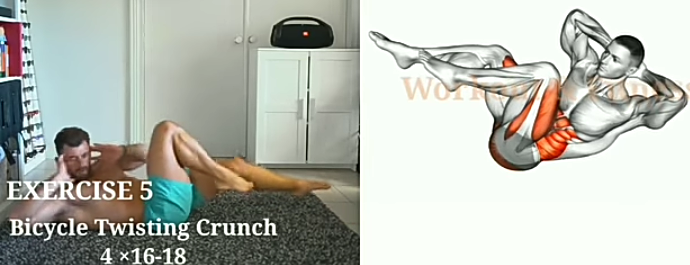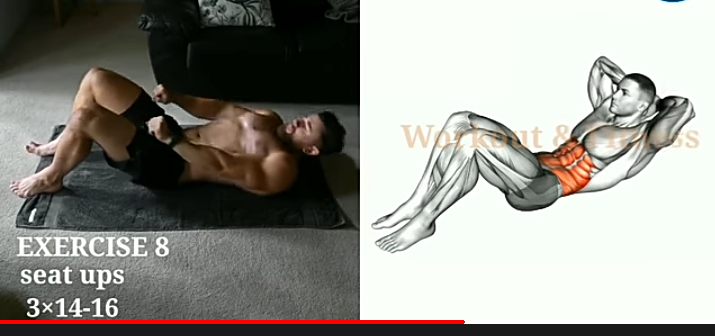
Exercise is any bodily activities that enhance or maintain physical fitness and overall health and wellness. It can be performed for so many reasons which includes, to develop six pack abs, to loss weight, to aid growth and improve strength, prevent aging , develop muscles and the cardiovascular system , weight loss or maintenance, improve health or simply for enjoyment.
Lists of exercises to develop six pack abs
So many people admires six pack abs as its always a notable physical sign of fitness. While there is no overnight secret to develop pack abs, regular exercise and a healthy diet can help put you on the fast track. This exercises can be helpful
Reversed crunch lift

To do Reversed crunch lift, lie flat on your back with your hands beneath your hips. Bend your knees and lift them towards your head, drawing them upward slightly at the end of the movement. Lower your feet back down just above the floor to complete one repetition. The effect of this is directly on the rectus abdominis muscle.
Wheel rollout

How to do Wheel rollout, ab wheel is required though a glove on a slippery surface can be used carefully. To begin,
-Kneel on the ground and place the ab wheel in front of you. Note: you may want to place a towel or mat under your knees.
-Grab the handles of the wheel and place all of your weight on the wheel.
-You can cross your legs or keep them straight back. Your feet can remain on the ground or you can lift your feet up, which requires more stability.
- Pull in your belly button towards your spine and engage your core.
Action:
a) Keeping your arms straight, slowly roll the wheel straight outwards. Roll out as far as you can before you feel your back arching.
b) Pause for a moment in this position. Then, squeeze your abs to slowly return to the starting position.
c) Maintain tightness in your core and repeat for the desired number of reps. The targets are Core muscles including the rectus abdominis, obliques, and erector spinae (lower back). It also works the shoulders and upper back.
Seated reverse crunch

Sit on a bench and lean back until your torso is at around at 45° angle. Hold your feet out in front of you and grip the bench with your hands for extra support. Draw your knees up to your chest, then slowly lower them. The targets are the transverse abdominis , the deep muscle below your abdominals, and your external obliques .
Side plank crunch

Support yourself on one forearm with your legs outstretched, feet stacked, and hips lifted. Hold your top arm behind your head.
Bend top leg and raise it to meet the same elbow while keeping your body stable in a straight line. Bring leg and arm back to the starting position in a steady, controlled motion. Side planks work the deep spinal stabilizing muscle quadratus lumborum . Keeping this muscle strong can help reduce your risk of a back injury.
Bicycle twisting crunch

Lift one leg just off the ground and extend it out. Lift the other leg and bend your knee towards your chest. As you do so twist through your core so the opposite arm comes towards the raised knee. You don’t need to touch elbow to knee, instead focus on moving through your core as you turn your torso.
The bicycle crunch is excellent for activating the rectus abdominis, your upper abdominal muscle, and it is second only to the captain’s chair for activating the obliques (your side abdominal muscles). Because you are raising your legs, you also engage the transverse abdominis, which is the deep ab muscle that is hard to target
Sit ups

Lie face-up on an exercise mat with your knees bent and your feet on the floor.
Place both of your hands on the sides of your head without interlocking your fingers. Your spine and pelvis should be in a neutral position. Slightly tuck your pelvis and bring your ribcage down. Engage your core. Your chin should remain tucked throughout the movement,as if you were holding an egg under your chin. All repetitions should begin from this position.
Begin the upward movement by squeezing your abs. Curl your upper body off the floor toward your knees while squeezing your abs. Pause at the top of the movement.
Slowly lower to the starting position while maintaining tension in your abs. Repeat for the desired number of repetitions.
Sit-ups work the rectus abdominis, transverse abdominis, and obliques in addition to your hip flexors, chest, and neck. They promote good posture by working your lower back and gluteal muscles.
With a larger range of motion, sit-ups target more muscles than crunches and static core exercises. This makes them an ideal addition to your fitness program. Read on to learn about some of the benefits of sit-ups, how to do them, and variations.





Nice one bro
Nice write up
Am gonna try this
Educating